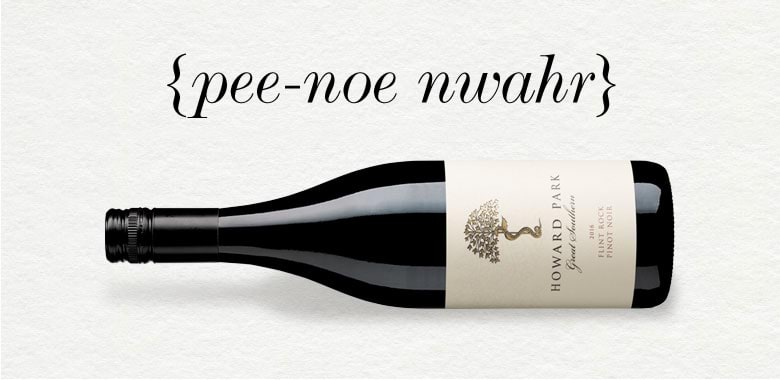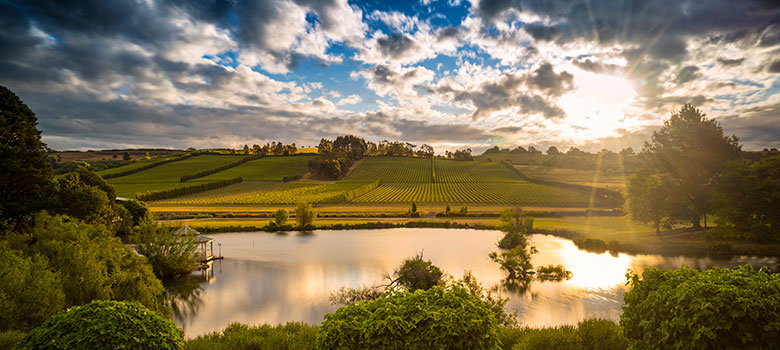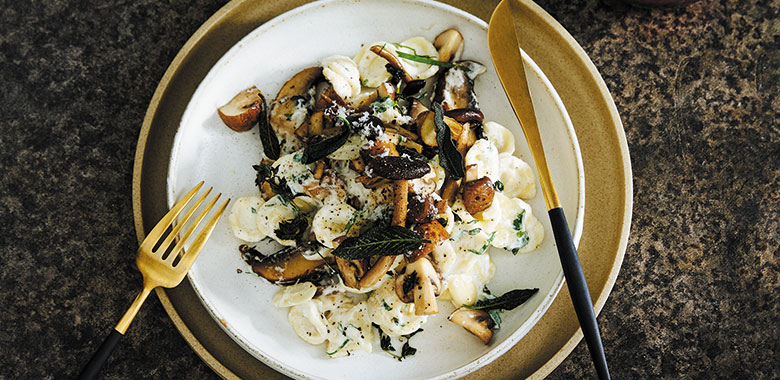
Wine
What is Pinot Noir?
Ahhhh, Pinot Noir, one of the most revered, collected, and celebrated red varietals in the world of wine! Top examples from its home in Burgundy sell for outrageous sums of money, but Australia has proven it can craft Pinot to compare with the world’s best.
What is Pinot Noir, and what makes it so special? Pinot Noir is generally quite delicate, and it takes a certain development of one's palate to truly appreciate its delightful nuances, perfumed aromas, textural elements and supple tannin profile.
In this varietal guide to Pinot, we look at its origin story, reveal the Australian regions where it grows best, share our picks for some of Australia’s best Pinot Noir producers, and serve up a selection of our favourite recipes to pair with Pinot Noir. Enjoy!
Shop Pinot Noir
An infographic guide to Pinot Noir
What does Pinot Noir tastes like?
Cranberry, Cherry, Raspberry, Clove, Leaf Litter
What are the best Pinot Noir wine regions?
Cool to moderate climates such as Tasmania, Yarra Valley, Adelaide Hills, and Mornington Peninsula.
What food does Pinot Noir pair with?
Gamey, earthy dishes or anything where mushrooms are the star.
How long can I cellar Pinot Noir?
Thanks to its fine tannin profile, the best Pinot Noir can be cellared with confidence for up to 10 years, or longer.
Profile characteristics of Pinot Noir
Pinot Noir is a medium-bodied wine.
Fact on Pinot Noir
Did you know Pinot Noir is over 1000 years older than Cabernet Sauvignon?
Origins of Pinot Noir
The hallowed soils of Burgundy, France, are believed to have given birth to Pinot Noir grapes.
Believed to be over a thousand years older than Cabernet Sauvignon, Pinot Noir gets its name from its distinctive grape cluster and colour, which looks like a dark pine-cone – Pinot is French for pine, and Noir means black or night.
Pinot Noir has been grown in France’s Burgundy region for centuries. Home to some of the world’s most expensive agricultural land, grapes for some of the world’s most costly Pinot Noir wines are cultivated in Burgundy’s iconic soils.
Pinot is a tricky grape to grow, and even trickier to make into wine. But what winemaker doesn’t love a challenge? The Burgundians have certainly nailed it – and no wonder, after thousands of years’ experience with its fickleness!
The cool climate and soil geology of Burgundy have both proven to be major factors in their success, but they’ve also shown the variety to be very site-specific – vines grown in adjacent vineyards, and even different spots within the same vineyard, can produce very different results.
Vine age is also critical. True of most varieties, but especially Pinot Noir, the best fruit tends to come from mature vineyards, considered to be around 15 years old or more. Yields need to be kept low to get the best out of this grape, as it needs all the flavour concentration it can get to show its best.
Pinot Noir in Australia
Pinot Noir grapes
It’s possible that a clone of Pinot Noir made its way to Australia with the First Fleet in 1788, and it was definitely part of the collection of vines that James Busby established in the Hunter Valley in the early 1800s.
Pinot Noir was planted unsuccessfully in the late 1800s in Coonawarra, but was better suited to conditions in the cooler conditions of southern Victoria, before phylloxera and other farming practises virtually wiped out the variety. The Yarra Valley’s re-emergence as a wine region from the 1960s onwards coincided with the rebirth of Pinot Noir, and today it is the most widely planted red varietal in that region.
Today, Pinot Noir is one of our most popular red wines, particularly as an alternative to fuller reds made from Shiraz and Cabernet Sauvignon. Demand for it is at an all-time high, and thanks to the tireless efforts of Australian winemakers, the quality has never been better. It’s also one of the three grape varieties used in the Méthode Traditionelle approach to Sparkling wine production, accounting for half of the Pinot Noir grown in Australia.
Australian winemakers have taken the lessons learnt in France to heart – gradually developing ever-cooler areas to grow Pinot, working out the best soil types, and carefully exploring the ideal sites within each vineyard to grow this fickle variety.
They're also working out the best clones and the most appropriate vine spacing, and then managing the vine canopy to allow just the right amount of dappled sunlight to reach the ripening bunches. Our vines are getting older, reaching that critical phase of maturity, and yields are managed carefully to coax the maximum from each berry.
Once in the winery, the grapes need careful handling due to their thin skins and low phenolic content, so physical pump-overs are kept to a minimum. These days more and more winemakers are including a percentage of stems in the ferment to enhance the aromatic and textural qualities of the finished wine, and oak usage is more skilfully matched to the style being produced.
Best Australian Pinot Noir Regions

Josef Chromy is renowned for its Pinot Noir
Australia’s cool climate regions are powerhouse Pinot Noir producers, from Tasmania in the south to Great Southern in the west. Here are the Australian regions that tend to do Pinot best.
Tasmanian Pinot Noir
Tasmania has an ideal climate for Pinot Noir, for both Sparkling and table wine production. Some of the most exciting Australian Pinot Noir is produced in Tasmania, particularly on the east coast. Among the top Tassie Pinot producers are the likes of Josef Chromy, Pooley Wines, Holm Oak, and Tamar Ridge.
Macedon Ranges Pinot Noir
Given its striking affinity with Pinot Noir, this cool, elevated region is among the finest in Victoria for the variety. Pinots from Macedon Ranges show restraint, power, finesse and complexity, all the hallmarks of great Pinot Noir. It’s also a serious Sparkling wine producing region. Producers like Joshua Cooper, Mount Macedon, and Curly Flat are familiar names to Pinot connoisseurs.
Geelong Pinot Noir
Home to some of the first great Australian Pinot Noir examples, the Geelong region and nearby Bellarine Peninsula produce concentrated wines with dark cherry and green olive fruit, and good depth. Keep your eyes out for Bannockburn, By Farr, Leura Park and Dinny Goonan for excellent examples of Geelong Pinot Noir.
Mornington Peninsula Pinot Noir
Some fine Australian Pinot Noirs are produced on the Mornington Peninsula. These wines are light and elegant yet show fabulous complexity and are often very approachable in their youth. Paringa Estate, Crittenden, Stonier and Red Hill are just some of the names to look for, for representative examples of Mornington Pinot.
Yarra Valley Pinot Noir
The Yarra Valley has made exceptional Pinot Noir for some time. The wines are light in character, elegant and very approachable in their youth. Rochford Estate, Giant Steps, Rob Dolan, De Bortoli, Boat O ‘Craigo, Yering Station and Toolangi are among the many Yarra Valley Pinot producers who have helped elevate the varietal in the minds and hearts of Australian wine lovers.
Adelaide Hills Pinot Noir
The soils and climate of the Adelaide Hills region makes it an ideal site for the cultivation of quality Pinot Noir, which tends to be medium bodied with richer, ripe cherry and berry flavours. Names like Petaluma, Shaw + Smith, Wicks Estate and Ashton Hills serve as standard bearers for Pinot from this iconic South Australian region.
Pemberton Pinot Noir
The cool Western Australian region of Pemberton is making a name for quality medium-bodied, complex Pinot Noirs with attractive new world flavours of plum, cassis and mocha. Silkwood, Hidden River and Smithbrook are among a clutch of boutique producers turning out quality Pinot Noir.
Great Southern Pinot Noir
We have seen a marked increase in the number and quality of Pinot coming from the West in recent years, particularly from the vast Great Southern area encompassing the five distinct sub-regions of Albany, Denmark, Frankland River, Mount Barker and Porongorup.
The resulting wines are varied with complex savoury styles emerging from Denmark; elegant, perfumed styles from Porongurup; rich fruit-driven styles from Mount Barker; big robust styles from Albany; and lighter primary fruit styles from Frankland River. Apricus Hill, Marchand & Burch, and Harewood Estate are producers to look for.
New South Wales Pinot Noir
The cool climate NSW regions of Tumbarumba and Orange are also being increasingly celebrated for their premium Pinot Noir. And surprisingly, there are small quantities grown in the Hunter Valley, where the tradition of blending Shiraz and Pinot, perfected by the legendary winemaker, Maurice O’Shea, is making a resurgence. Names to look for include McWilliam’s (from their Tumbarumba vineyards), Rowlee, Gilbert Family Wines and Cook’s Lot (Orange), and Pinot/Shiraz blends from Keith Tulloch and Carillion.
What does Pinot Noir taste like?
Australian Pinot Noir is typically low in colour pigmentation, has a perfumed nose and shows red fruit such as cherry, red berry and blood plum flavours.
Great Aussie Pinot Noir should age well and develop complex truffle, game and earthy characters, hinting at its origins or the soil it came from. Its fruit flavours are balanced by tannins that are typically fine and soft, expanding at the back of the palate – referred to as a peacock’s tail finish.
The best examples age well and often take some years to realise their true character. When tasting Pinot Noir, it’s worth bearing in mind that it’s not a big red wine, but is all about delicacy and length, harmony and finesse.
Best Food Pairings for Pinot Noir

Pinot Noir is one of the world’s great food wines. Its bright acidity, fruit flavours and textural tannins make it a good match for everything from salmon to charcuterie, with fuller-bodied examples pairing quite well with chargrilled steak and lamb.
Generally though, its elegance and nuance means it can be overwhelmed by bigger flavours like spices or rich red meats, so be mindful of that when thinking of matching it with heavier dishes. It’s also a delight with comté cheese!
Best recipes to pair with Pinot Noir
Wine Selectors is privileged to have a diverse range of Pinot Noir in our cellar, from great Pinot regions like Adelaide Hills, Tasmania, Mornington Peninsula and more. They’re all there ready for you to explore – so grab your glasses and start your Pinot Noir journey with Wine Selectors!